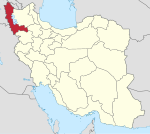Salmas: Difference between revisions
m r2.6.4) (robot Adding: pnb:سلماس |
No edit summary |
||
| Line 1: | Line 1: | ||
[[File:Salmas türbəsi.jpg|thumb|right|Tomb of Salmas]] |
[[File:Salmas türbəsi.jpg|thumb|right|Tomb of Salmas]] |
||
'''Salmās''' or '''Salamas''' ({{lang-fa|سلماس}}), also '''Shahpur''', '''Dīlman''', and '''Dīlmagān''', is a city in [[West Azarbaijan Province]] of [[Iran]]. The town is of [[Azeri]] origin, according to the Arabic geographer Mukadassi who visited Salmas in the 10th century<ref>The lands of the eastern caliphate: Mesopotamia, Persia, and Central Asia, by Guy Le Strange</ref> In a 2006 census, the city had a population of 79,560. It is the administrative seat of [[Salmas County]] and [[Salmas Central District]]. The population is a mixture of [[Azeri]], [[Assyrian people|Assyrians]], [[Kurds]] and [[ |
'''Salmās''' or '''Salamas''' ({{lang-fa|سلماس}}), also '''Shahpur''', '''Dīlman''', and '''Dīlmagān''', is a city in [[West Azarbaijan Province]] of [[Iran]]. The town is of [[Azeri]] origin, according to the Arabic geographer Mukadassi who visited Salmas in the 10th century<ref>The lands of the eastern caliphate: Mesopotamia, Persia, and Central Asia, by Guy Le Strange</ref> In a 2006 census, the city had a population of 79,560. It is the administrative seat of [[Salmas County]] and [[Salmas Central District]]. The population is a mixture of [[Azeri]], [[Assyrian people|Assyrians]], [[Kurds]] and [[Persian people|Persians]]s. |
||
==History== |
==History== |
||
Revision as of 17:18, 23 June 2011

Salmās or Salamas (Persian: سلماس), also Shahpur, Dīlman, and Dīlmagān, is a city in West Azarbaijan Province of Iran. The town is of Azeri origin, according to the Arabic geographer Mukadassi who visited Salmas in the 10th century[1] In a 2006 census, the city had a population of 79,560. It is the administrative seat of Salmas County and Salmas Central District. The population is a mixture of Azeri, Assyrians, Kurds and Persianss.
History
Early mention of Salmas was made in 1281, when its Assyrian bishop made the trip to the consecration of the Assyrian Church of the East patriarch Yaballaha in Baghdad.[2]
In the Battle of Salmas, 17-18 September 1429, the Kara Koyunlu were defeated by Shah Rukh who was consolidating Timurid holdings west of Lake Urmia.[3] However, the area was retaken by the Kara Koyunlu in 1447 after the death of Shah Rukh.
In Salmas in March 1918 the Patriarch of the Assyrian Church of the East, Mar Shimun, was murdered by the Kurdish chieftain Simko Shikak,[4][5][6] grandson of the Shakkak chieftain 'Ismail Agha' (d. 1816).[2]
Part of the Assyrian Genocide took place in Salmas and the surrounding region at the hands of the Ottoman Army and loyal Kurdish irregulars. This followed initially successful Assyrian military campaigns against the Ottomans and their Kurdish and Azeri allies.
See also
Notes
- ^ The lands of the eastern caliphate: Mesopotamia, Persia, and Central Asia, by Guy Le Strange
- ^ a b Houtsma, M. Th. et al. (1993 reprint) "Salmas" E. J. Brill's First Encyclopaedia of Islam, 1913-1936 Volume 4, E.J. Brill, New York, page 118, ISBN 90-04-09796-1
- ^ Houtsma, M. Th. et al. (1993 reprint) "Tabrīz" E. J. Brill's First Encyclopaedia of Islam, 1913-1936 Volume 4, E.J. Brill, New York, page 588, ISBN 90-04-09796-1
- ^ Houtsma, M. Th. et al. (1993 reprint) "Shakāk" E. J. Brill's First Encyclopaedia of Islam, 1913-1936 Volume 4, E.J. Brill, New York, page 290, ISBN 90-04-09796-1
- ^ O'Shea, Maria T. (2004) "Trapped Between the Map and Reality: Geography and Perceptions of Kurdistan Routledge, New York, page 100, ISBN 0-415-94766-9
- ^ Nisan, Mordechai (2002) Minorities in the Middle East: A History of Struggle and Self-Expression (2nd edition) McFarland, Jefferson, North Carolina, page 187, ISBN 0-7864-1375-1
External links
- Salmas ancient location
- Salmas famous people
- Salmas, By C.E. Bosworth, Encyclopaedia of Islam.
- "Salmas Map — Satellite Images of Salmas", Maplandia

